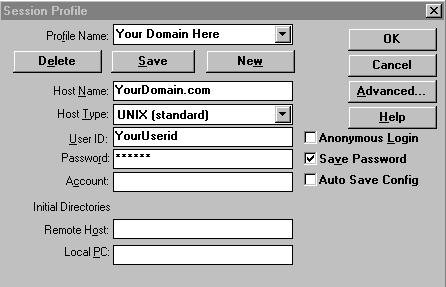| The
process by which files are transferred to the web
server is called "FTP" (File Transport
Protocol). You have unlimited access via FTP 24-hours
a day. As such, you can create and maintain your
web pages on your own computer and upload files
to your web site at your leisure.
Internet
providers such as AOL, CompuServe, and Prodigy
may have a built-in FTP interface. If you have
a PPP internet account and need an FTP program.
Configuring
Your FTP Software
The
following information is contained within your
account activation notice and is needed to connect
to your web site via FTP:
- USERID
- PASSWORD
- FTP
HOSTNAME
The
hostname tells your FTP software to connect
to the web server upon which your web site resides.
In general, the process of configuring the various
FTP software/interface is the same. We recommend
WS_FTP for PC computer users and will be
using it in the upcoming examples.
Each
time you run WS_FTP the Session Profile window
will be displayed. A profile contains the information
needed to connect to your web site. Creating a
profile now will eliminate the need for you to
configure the software each time you wish to connect
to the web server via FTP. To create a new profile,
click the "New" button and enter a generic
profile name at the top of the Session Profile
window. Next, enter the userid, password and hostname
for your web site as illustrated below.
Fig.1

Be
sure to always select "Automatic Detect"
for the Host Type. (see Fig.1) It is best to select
"Save Password" and "Auto Save
Config" to maintain these settings for future
use. All other fields can be left blank. You are
now ready to connect to the web server. Click
"Ok" to continue.
How
to Transfer Files
When
you connect to the web server, you will connect
directly to the root ("home") directory
of your account. WS_FTP will display a split screen
where files on the left-hand side are within your
own computer. You will see several folders on
the right-hand side such as yourdomain-www, and
yourdomain-logs which are landmarks suggesting
a successful connection to your web site.
You
need to click on yourdomain-www to get to your
web directory, this is where all your files will
be downloaded, and/or you will create subdirectories.
The only system directory that you may need to
use is cgi-bin; this directory is reserved for
custom scripts. To make your home page load automatically,
name the HTML document "index.html"
in lowercase and upload it to the yourdomain-www
directory of your account. To upload a file or
files, simply highlight the file(s) on the left
and click the right-arrow button (=>) in the
center of the screen. Be sure to upload HTML documents
and scripts in ASCII mode and images in BINARY
mode. To transfer a file to a subdirectory, double-click
the appropriate subdirectory to open it before
transferring the desired file(s).
As
soon as a file is uploaded to the web server,
it is available for all to see. If, after uploading
a file, you are still unable to see the updated
file via Netscape, you need to clear both disk
and browser cache. This function can be found
by selecting Options > Network Preferences
in Netscape. Remember that you must first be connected
to the internet through your local internet service
provider in order to connect to the web server.
Notes
to Mac Users
- Select
"raw data" transfer mode when using
Fetch to transfer both HTML and images.
|









